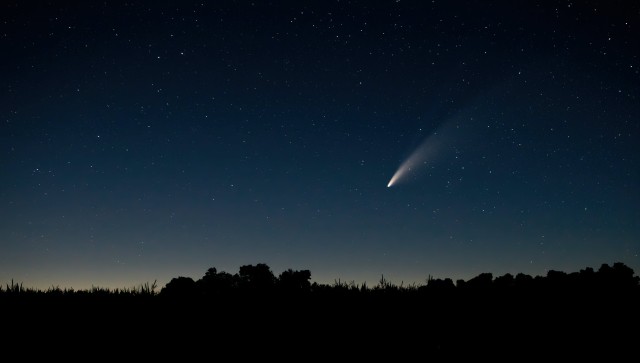Comets have made headlines, but not because of their brightness. As the new year draws near, scientists have discovered a comet that may come close to Earth in the upcoming months. When a Devil Comet, also called 12P/Pons-Brooks, approaches Earth’s surface, sky gazers may be able to see it with their naked eyes or using binoculars. Here’s all we know about the comet. About the Devil Comet The Devil comet may come very close to Earth in March 2024, according to a Space.com report. About three-quarters of Earth’s distance from the Sun is covered by 12P/Pons-Brooks when it is near the Sun’s orbit. Because of its similarities to the orbits of three other comets, 13P/Olbers, 23P/Brorsen-Metcalf, and the now-defunct 20D/Westphal, the comet is known as Neptune’s family of comets. It is the brightest comet in the family. The comet earned the nickname “ Devil ” in July this year when astronomers observed horns surrounding its nucleus, which come what looked like Star Wars. It is believed to be three times the size of Mount Everest, which stands tall at the height of 29,029 feet or around 5.5 miles. It is challenging to estimate the size of a comet without directly seeing it with a spacecraft or radar, but a 2020 study published in Research Notes of the AAS calculated the comet’s nucleus, or the piece of ice and rock that makes up the comet, to be about 10.5 miles (17 kilometre) across based on the comet’s brightness at the time. Yes, that is larger than Everest. However, they caution that this may be an overestimate because of the difficulties in precisely determining the boundary between the comet’s nucleus and the coma, which is composed of gas, ice, and dust that escapes the surface. Its size and shape are very similar to the well-known Halley’s Comet, however Halley moves in the opposite direction from the planets—that is, retrograde, according to Astronomy.com. Appearances The comet has been in the solar system for a long time. On 21 July 1812, French astronomer Jean Louis Pons made the first observation of it at a magnitude of 6.5, close to the two faint constellations Camelopardalis and Lynx, according to Space.com. Significantly, magnitude expresses the brightness level of an object. The subject is brighter the lower the figure of magnitude. Later, in November 1883, the comet returned with a “flare” to a magnitude of 3.0, and in 1953–54, it reached a magnitude of 6.4. Since 10 June 2020, the comet has been visible via the Lowell Discovery Telescope in Arizona, as per Hindustan Times. Brightness flare-ups At the moment, the comet is visible through large telescopes because to its brightness, which is approximately 10.0. But in the upcoming months, as it approaches the planet, its brightness will increase. The comet is reportedly having brightness flare-ups, according to scientists. It is now anticipated to move slowly in the direction of the Lyra and Cygnus constellation, which is southeast. By the end of February, it should brighten up to magnitude seven. It will pass past Andromeda’s borders later in the first week of March. By the end of the month, its brightness will approach magnitude five, making it visible to the unaided eye or through binoculars in the zodiacal constellation of Aries. The comet underwent an outburst NDTV reported that this is 12P’s second explosion since 20 July, when the intergalactic snowball burst its stack for the first time in 69 years. The horn-shaped emissions that were produced during this explosion were 7,000 times wider than the comet itself. The coma has subsequently returned to its normal size but might draw greater attention the next year if it keeps exploding, which Space Weather Archive predicts will happen. According to Miles, 12P is one of 20 known comets with active ice volcanoes. It was first identified on 12 July 1812, by Jean-Louis Pons. With inputs from agencies
A comet, three times the size of Mount Everest, may come very close to Earth in March 2024. 12P/Pons-Brooks is the *brightest comet of the Neptune’s family. It earned the nickname ‘Devil’ in July this year when astronomers observed horns surrounding its nucleus
Advertisement
End of Article


)

)
)
)
)
)
)
)
)



